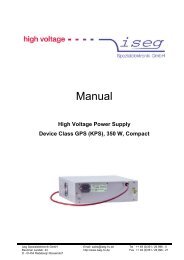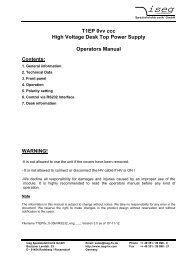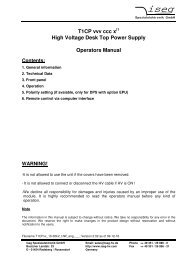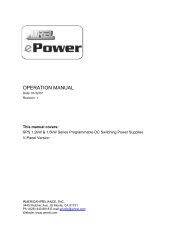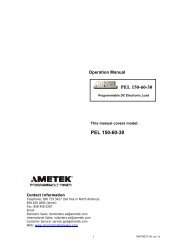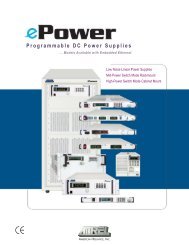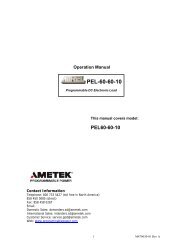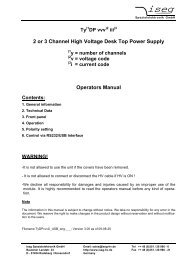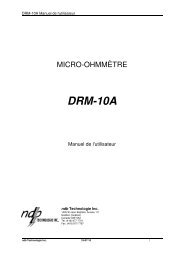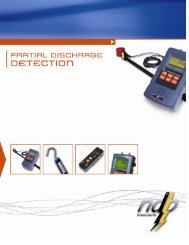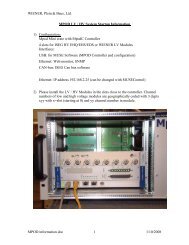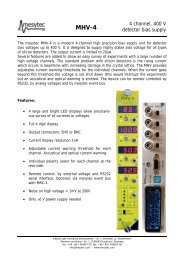HigH Voltage Pulsed generators - Physical Instruments
HigH Voltage Pulsed generators - Physical Instruments
HigH Voltage Pulsed generators - Physical Instruments
You also want an ePaper? Increase the reach of your titles
YUMPU automatically turns print PDFs into web optimized ePapers that Google loves.
<strong>HigH</strong> <strong>Voltage</strong> <strong>Pulsed</strong> <strong>generators</strong>
HV pulse technology for Plasma Immersion Ion<br />
Implantation and other applications<br />
GBS Elektronik GmbH started in 1997 to manufacture<br />
customized pulse <strong>generators</strong> for plasma based<br />
ion implantation applications. This extended to a<br />
full spectrum of pulse <strong>generators</strong> based on different<br />
principles. Now the range offered is from 1- 50 kV<br />
peak voltage and from 1-120A peak current.<br />
Where the first pulse <strong>generators</strong> were based on electron<br />
tubes (RUP1, RUP2, RUP4, RUP5) now the majority<br />
of high power <strong>generators</strong> is based on IGBT stacks<br />
(RUP6). For the range below 15kV peak voltage and<br />
5A peak current pulse <strong>generators</strong> with MOSFET<br />
switch modules (RUP3 series) have been successfully<br />
implemented. All the RUP series (Rossendorf Universal<br />
Pulse generator) deliver mostly square wave<br />
pulses, and can deal with a broad range of load impedances.<br />
Pulse parameters (frequency, pulse width,<br />
amplitude) are freely adjustable.<br />
Also the range of applications has been extended.<br />
So we offer power supplies for magnetron sputtering<br />
(RUPmag), High Power Impulse Magnetron Sputtering<br />
(RUP7, 1kV, up to 400A), Dielectric Barrier Discharges<br />
(Minipuls, HFpuls).<br />
But also applications far from surface treatment have<br />
been served. This includes treatment of liquids (Hydropuls)<br />
beam deflection in particle accelerators,<br />
pulsing of ion sources extraction, driving of ignitrons,<br />
spark gap triggering and piezo control.<br />
Some of the smaller pulse generator designs as well<br />
as HV supplies are available as OEM version (documented<br />
circuit boards without housing). This is interesting<br />
for customers with tight budget as well as for<br />
customers which want to integrate HV technology<br />
into their own devices.<br />
Our strength is to offer customized and new to be<br />
developed high voltage devices within short lead<br />
time. So ask us if your application is very special and<br />
you are not served elsewhere.
The ion beam center of the Institute of Ion Beam<br />
Physics and Materials Research at the Dresden-Rossendorf<br />
Research Center carries out basic research in<br />
the areas of materials science as well as modification<br />
and analysis of solid surfaces using ion beams.<br />
In addition to various types of metal, hard material<br />
and functional layers for biomedical, electronic, magnetic,<br />
optical and tribological applications, semiconductor<br />
layers are also a research emphasis.<br />
The Institute operates a cross-regional and international<br />
ion beam center, user facility of the European<br />
Community as CENTER FOR APPLICATION OF ION<br />
BEAMS IN MATERIALS RESEARCH (AIM) and SUPPORT<br />
OF PUBLIC AND INDUSTRIAL RESEARCH USING ION<br />
BEAM TECHNOLOGY (SPIRIT) which makes its facilities<br />
available to outside users from universities, other<br />
research institutes and industry from the European<br />
Union while offering services such as technology<br />
transfer related to ion beam technologies.<br />
The effect of ion bombardment on the generation<br />
and modification of thin films is studied experimentally<br />
and using computer simulation. In the experimental<br />
area targeted in situ real time diagnostic<br />
procedures are employed in order to understand the<br />
processes in detail and optimise them. The focus of<br />
the studies includes, in addition to the relationships<br />
between structure and properties, various possible<br />
applications. An important component of the research<br />
and development on new thin film systems<br />
is the use of low-energy ions and the use of pulsed<br />
plasma for generating metastable phases, high film<br />
densities, extraordinary adhesion of films, nanostructures<br />
or special textures.<br />
A closed cooperation and interaction with industrial<br />
partners is focused on the technology transfer of<br />
modern ion technologies and the development of<br />
high-tech equipment in this field.<br />
http://www.fzd.de
Main research topics in FZD using pulse<br />
<strong>generators</strong> of GBS Elektronik GmbH<br />
� Tribological improvement of steel by nitrogen<br />
PBII<br />
� Nitridation of steel or other metals and alloys by<br />
PBII<br />
� Deposition of hard coatings by PBII+Deposition<br />
(TiN)<br />
� Improvement of HT oxidation behaviour of TiAl<br />
by halogenes PBII<br />
� Nanoporous stainless steel surfaces for medical<br />
applications by noble gas PBII<br />
� Emitter doping in photovoltaics by PBII<br />
� Reactive MF pulsed dual magnetron sputtering<br />
of TCO<br />
� Reactive MF pulsed dual magnetron sputtering<br />
of optical and semiconducting oxides<br />
� Deposition of stress relaxed cubic BN films<br />
HV Pulse generator RUP3-3A<br />
Custom made high voltage pulse <strong>generators</strong> in the<br />
range of 1 - 45 kV peak voltage, kW to MW peak<br />
power and 0.1 - 12 kW average power.<br />
For research equipment the RUP series (Rossendorf<br />
Universal Pulse Generator) were developed:<br />
Common to all RUP pulse <strong>generators</strong> is, that they<br />
deliver square wave pulses, can deal with a broad<br />
range of load impedances, tolerates short circuits<br />
and arcs, and pulse parameters (frequency, pulse<br />
width, amplitude) can be freely adjusted.<br />
For applications where the demand for voltage,<br />
peak current and power is limited, the RUP3 is a<br />
good choice.<br />
It switches a DC voltage with a MOSFET switch<br />
module to the output. The MOSFETs are protected<br />
by current limiting series resistors.<br />
Waveform: Arbitrary square wave, duty cycle up to<br />
DC operation. Ultrafast rise and fall times, at the<br />
lower voltages typically
For applications demanding high voltage but limited<br />
current, the RUP4 is still resonable.<br />
Its topology is quite simple. As switch a hard tube<br />
(tetrode) is used, the output is capacitively coupled.<br />
Waveform: Square wave with fast rise (~1µs) and<br />
decay depending on load. Without load, fall is determined<br />
by the HV power supply and in the order<br />
of 100µs. Duty cycle should be
Typical used HV pulse <strong>generators</strong> for PBII<br />
Typ<br />
RUP1<br />
RUP2<br />
RUP3<br />
RUP3-2/6b<br />
RUP3-3a<br />
RUP3-5a<br />
RUP3-5aN<br />
RUP3-5aRS232<br />
RUP3-5/1a<br />
RUP3-10B<br />
RUP3-10bip<br />
RUP3-10/5<br />
RUP3-12/30<br />
RUP3-15/50a<br />
RUP4<br />
RUP4r<br />
RUP4a<br />
RUP4n<br />
RUP4b<br />
RUP4-1b<br />
RUP5<br />
RUP6-1/5<br />
RUP6-3x2<br />
RUP6-6d<br />
RUP6-10<br />
RUP6-10<br />
RUP6-10ciws<br />
RUP6-12<br />
RUP6-12b<br />
RUP6-20<br />
RUP6-22a<br />
RUP6-22b<br />
RUP6-25<br />
RUP6-25<br />
RUP6-25r<br />
RUP7<br />
RUP7<br />
U max (kV)<br />
100<br />
50<br />
5<br />
2<br />
3<br />
5<br />
5<br />
5<br />
5<br />
10 (add. +/- 200V BIAS<br />
10<br />
10<br />
12<br />
15<br />
30<br />
40<br />
50<br />
30<br />
30<br />
40<br />
60<br />
1<br />
3<br />
6<br />
10<br />
10<br />
10<br />
12<br />
12<br />
20<br />
22<br />
22<br />
25<br />
25<br />
25<br />
1<br />
1<br />
I max (A)<br />
10<br />
4<br />
10<br />
10<br />
6<br />
1<br />
1<br />
1<br />
2<br />
10<br />
10<br />
5<br />
30<br />
5<br />
32<br />
32<br />
24<br />
8<br />
24<br />
8<br />
100<br />
100<br />
2*40<br />
50<br />
80<br />
40<br />
120<br />
90<br />
90<br />
30<br />
50<br />
50<br />
30<br />
30<br />
30<br />
450<br />
450<br />
P average (kW)<br />
1.5<br />
1<br />
0.3<br />
0.2<br />
0.3<br />
0.1<br />
0.1<br />
0.1<br />
0.9<br />
0.9<br />
0.5<br />
5<br />
3<br />
0.75<br />
4<br />
8<br />
6<br />
1.5<br />
1.5<br />
2<br />
10<br />
5<br />
1.2<br />
2.5<br />
2.5<br />
2.5<br />
12<br />
2.5<br />
6<br />
2.5<br />
2.5<br />
2.5<br />
2<br />
2.5<br />
2<br />
3<br />
3
The device serie RUP (Rossendorf<br />
Universal Pulse Generator)<br />
includes all <strong>generators</strong><br />
with a broad spectrum of<br />
impedances and parameters<br />
(frequency, pulse length, amplitude).<br />
The serie Ecopuls represents<br />
a number of low cost and low<br />
power pulse <strong>generators</strong> using<br />
a pulse transformator. Many<br />
different special solutions can<br />
be offered.<br />
Special solutions<br />
� ECOPULS 2 is a cost effective<br />
solution for PBII.<br />
� Ignitronpuls for applications<br />
with four ignitrons<br />
with high current pulses<br />
with low repitition.<br />
� RUPmag 800 V, 1 kW,<br />
flexible power supply for<br />
pulsed dual magnetron<br />
sputtering with two unipolar<br />
or alternative bipolar<br />
exits<br />
� RUPmag2 dual power<br />
supply for pulsed dual<br />
magnetron sputtering<br />
(low power 2*100W),<br />
high frequencies (up to<br />
200 kHz).<br />
produced by GBS Elektronik GmbH<br />
Universal High <strong>Voltage</strong> Pulse Generators<br />
� RUP 1, basing on Tetrode TH5188, max. 100 kV, 10 A,<br />
modular construction (old version)<br />
� RUP 2, basing on Tetrode 4PR250C, max. 45 kV, 4 A,<br />
modular construction (old version, RUP4 is the better solution)<br />
� RUP 3, basing on MOSFET-HV switch modules,<br />
many versions up to 15 kV.<br />
� RUP 3-2/6 (-2kV Pulse, -200V Bias voltage, 200 + 200W)<br />
� RUP 3-3A (-3kV Pulse, 300W)<br />
� RUP 3-5A (5kV Pulse, 100W)<br />
� RUP3-5/1A (5kV Pulse, 1kW)<br />
� RUP 3-5 (-5kV Pulse, 1kW)<br />
� RUP3-5ion for pulsed mode of an ion source 5kV/2A average<br />
current; second exit for synchronisation of the extraction grid.<br />
� RUP 3-10B (-10 kV Pulse, +/- 200V Bias voltage, 500 + 200 + 200 W)<br />
� RUP 3-10/5 (+10 kV Pulse, 5kW)<br />
� RUP3-15A (-15kV Pulse, 750W)<br />
� RUP3-7bip Bipolar Pulse Generator +/- 7.5 kV, 2*500W<br />
� RUP 4, basing on tube 8960. max. 45 kV/32A.<br />
� RUP4-1, 40kV, 8A peak, 2kW average power.<br />
Recommended economic solution for high voltage<br />
and moderate current or power.<br />
� RUP 5, basing on tube Y546. max. 55 kV, 90A.<br />
� RUP 6, basing on stapled IGBT switch modules.<br />
Different voltage versions can be offered current<br />
max. 50A, optional max. 120A possible.<br />
� RUP6-1c (-1kV, 100A peak, 5kW)<br />
� RUP 6-6d (-6kV, -200V Bias, additional 500V-high<br />
current pulse mode, 2.5kW)<br />
� RUP 6-10 (-10 kV Pulse, 2.5 kW)<br />
� RUP 6-10i (3-10kV tuneable, 120A, 12kW)<br />
� RUP 6-12 (-12 kV Pulse, 2.5 kW)<br />
� RUP 6-12c (-12 kV Pulse, 120 A peak, 6 kW)<br />
� RUP 6-20 (-20 kV Pulse, 2.5 kW)<br />
� RUP 6-22a (22kV Pulse, resonant switcher,<br />
max. frequency 5kHz at half voltage)<br />
� RUP 6-22b (-22 kV Pulse, -200 V Bias voltage, 2.5 kW + 200 W)<br />
� RUP 6-25 (-25 kV, 2.5 kW)
Surface hardening and wear protection<br />
of metals by PBII<br />
If proper ions are implanted into metallic substrates,<br />
for instance nitrogen ions in titanium, the surface<br />
sensitive properties of the substrate material are<br />
remarkably changed, hence due to the stopping<br />
range of the implanted ions, in case of PBII only up<br />
to a depth of less than 1 µm. Larger modification<br />
depth’s will be obtained, if the implantation is done<br />
at elevated temperatures, resulting in a diffusion of<br />
the implanted ions.<br />
Further investigations concern the nitridation and<br />
boronisation of HSS and hard metals and surface<br />
hardening of Al and Mg in many medical applications.<br />
Nitrogen ion implantation into austenitic stainless<br />
steel at elevated temperatures of 350 – 400 °C<br />
leads to a significant increase in the surface hardness<br />
while the specific wear volume is reduced by<br />
several orders of magnitude. A fast diffusion leads<br />
to the formation of layers with a thickness of up<br />
to 0.05 mm in a technologically useful timeframe.<br />
The surface hardness itself reaches values between<br />
1300 and 1700 HV, thus the obtained layer thickness<br />
is more than sufficient for typical applications.<br />
At the same time, the corrosion properties of the<br />
base material are maintained.<br />
(Forschungszentrum Dresden Rossendorf applied RUP1, RUP4,<br />
and RUP6)<br />
Nitrided layer by PBII<br />
X%CrNiMo 17.12.2, Plasma Based Ion Implantation,<br />
40kV, 380 ˚C, 10 hours<br />
Basic material<br />
Nitrided layer<br />
Wear improvement by PBII<br />
Corrosion behaviour after PBII in comparison to untreated and<br />
plasma nitrided surfaces<br />
X5CrNiMo17.12.2
MF <strong>Pulsed</strong> Reactive Dual Magnetron<br />
Sputtering of Nb2O5<br />
Hydrogen depth profile obtained by nuclear reaction analysis<br />
data for Nb2O5 films with open (blue) and closed (red) pores.<br />
Optical applications require highly homogeneous,<br />
amorphous oxide material with high refractive index,<br />
low extinction, mechanical stress and thermal<br />
shift. The reactive pulsed magnetron sputter deposition<br />
facility is optimized to produce dense Nb2O5<br />
films with refractive index n>2.5 and extinction coefficient<br />
k~6x10-4 at light wavelength of 400 nm,<br />
mechanical stress of -90 MPa, nearly zero thermal<br />
shift, and hydrogen content below 1%. The optimum<br />
films are denser compared to ordinary ones,<br />
and contain closed pores (Nb2O5_1_closed pores,<br />
Nb2O5_1_open_pores).<br />
Such closed pores should relax the mechanical<br />
stress and do not lead to significant thermal shift of<br />
the optical properties. The nuclear reaction analysis<br />
data show that the optimum films are nearly hydrogen<br />
free, which confirms assumption about the<br />
closed pores (Nb2O5_2).<br />
(Forschungszentrum Dresden Rossendorf applied RUPmag)<br />
Overview TEM images of the Nb2O5 films grown by reactive<br />
medium frequency pulsed magnetron sputtering with open<br />
and closed pores.
Advanced Implantation and Coating<br />
Technology Based on Combination of<br />
Magnetron Sputtering or Cathodic Arc<br />
System and RF Plasma Source with PBII<br />
The main advantage of metal plasma based ion<br />
implantation and deposition (MePBIID) compared<br />
to conventional thin film deposition technologies<br />
is the athermal energy deposition by the accelerated<br />
ions, causing an atomic mixing of the interface<br />
zone. Thus, excellent adhesion is achieved even at<br />
room temperature.<br />
Analogous to ion beam assisted deposition, textured<br />
thin films are obtained for MePBIID. By varying<br />
the pulse voltage and the pulse length different<br />
film orientations can be achieved. Despite a columnar<br />
growth mode with column diameters between<br />
50 and 500 nm, compact, dense and pore-free thin<br />
film are obtained.<br />
Equipment and technology:<br />
� Inductively coupled RF discharge produces<br />
mainly plasma of gaseous ions<br />
� Magnetrons or arc produce a mixture of gaseous<br />
and metal ions and neutrals<br />
� Magnetrons can change metal-ion to metalneutral<br />
ratio depending on operation conditions<br />
� Use of noble gases allows metal ion implantation<br />
and/or subsequent metal deposition assisted<br />
by noble gas ion implantation<br />
� Use of oxygen or nitrogen allows formation of<br />
oxide and nitride films with with high adhesion<br />
by high energy ion assistance.<br />
Metal plasma generated by two magnetrons in the configuration<br />
for implantation
Advanced Implantation and Coating<br />
Technology Based on Combination of<br />
Magnetron Sputtering or Cathodic Arc<br />
System and RF Plasma Source with PBII<br />
Magnetrons above the PBII sample holder provide<br />
a high deposition rate of metal, oxide or nitride<br />
films. At the start of deposition magnetrons should<br />
work in HPIMSM mode generating a dense plasma<br />
needed for the creation of an mixed interface layer<br />
by PBII ion assistance for good film adhesion. After<br />
that the magnetrons should work in normal meanpower<br />
high duty cycle mode with high deposition<br />
rate.<br />
(Forschungszentrum Dresden Rossendorf applied RUP4 and<br />
RUP6)
Nanostructured metal surfaces by PBII<br />
(cardiovascular application)<br />
Various passageways such as arteries, other blood<br />
vessels sometimes become occluded or weakened.<br />
For example, the passageways can be occluded by<br />
a tumor, restricted by plaque, or weakened by an<br />
aneurysm. A passageway can be reopened or reinforced,<br />
or even replaced, with a medical endoprosthesis<br />
(stents or stent-grafts). For bare metal stent<br />
the in-stent restenosis was still a serious problem<br />
for some patients and this spurred the medical<br />
device companies to come up with a solution that<br />
was more effective at preventing restenosis. In the<br />
late 1990’s the first drug eluting stents (DES) were<br />
developed as a solution to the problem of restenosis.<br />
PBII of noble gases in metal can provide a formation<br />
of medical devices with porous surface.<br />
Advantages of nanostructured metal:<br />
� Storage of therapeutic agents or drugs in the<br />
surface;<br />
� High biocompatibility;<br />
� A base for other coatings or bio-layers.<br />
Nanoporous bubble structures ➇<br />
� high-dose helium implantation >10 18 cm -2<br />
helium concentrations U 20 at.%<br />
� temperatures U 0.2Tm<br />
� Ion energy: 30keV<br />
(Forschungszentrum Dresden Rossendorf applied RUP1 and<br />
RUP6)<br />
By high compressive stress delaminated cBN thin film<br />
Stress development at cBN growth without ion induced<br />
relaxation<br />
Stress relaxation under simultaneous high energy ion<br />
bombardment
Ion induced stress relaxation in cBN<br />
by pulsed ion implantation<br />
Pulse schema of BIAS for quasi stress free cBN coating<br />
RF magnetron sputter equipment with complex BIAS for cBN<br />
deposition<br />
The deposition of cubic boron nitride films as a super<br />
hard coating is very limited by the formation<br />
of extreme high intrinsic stress and the resulting<br />
delamination of the coating from the substrate at<br />
film thicknesses lower 100nm. This high compressive<br />
stress is caused by the low energy (< several<br />
hundreds eV) recoil implantation of film forming<br />
species nitrogen and boron, by densification and<br />
by defect production in the growing films.<br />
At biased rf magnetron sputter processes stress of<br />
more than 10GPa was measured. Under simultaneously<br />
application of a second ion energy (higher<br />
than several keV) it was obtained a 90% stress relaxation<br />
of the growing film by atomic displacements<br />
under the surface. A complex pulsed bias of<br />
the cBN growth with pulse voltages of<br />
� For cBN growth: -100 to -180 V<br />
� For stress relaxation: -2.5 to -8 kV<br />
� For Surface discharge: +80V<br />
(see pulse schema) enables a poor stress growth<br />
process for µm thick cBN hard coatings.<br />
(Forschungszentrum Dresden Rossendorf applied RUP3-10B)<br />
RF plasma of N2/Ar for cBN deposition
Efficient oxydation protection of TiAl<br />
alloys by plasma based ion implantation<br />
of halogens<br />
Metallographic cross-sections of unimplanted (left) and all-side<br />
fluorine-implanted _-TiAl sample (right). Isothermal oxidation at<br />
900 °C for 120 h in air.<br />
Problem<br />
Poor oxidation resistance at<br />
temperatures above 700 °C<br />
Temperature range required<br />
for advanced structural<br />
applications: 700 ° – 1100 °C<br />
Solution<br />
(Forschungszentrum Dresden Rossendorf applied RUP4 and RUP6)<br />
� The best solution – ion<br />
implantation of halogens<br />
(notably chlorine and<br />
fluorine)<br />
� Beamline ion implantation<br />
(BLII)<br />
� Plasma immersion ion<br />
implantation (PBII)<br />
Effect<br />
TiAl alloys modified by ion implantation<br />
of halogens acquire a stable,<br />
adherent and highly protective<br />
scale against environmental<br />
oxidation while retaining the bulk<br />
mechanical properties of the starting<br />
material.<br />
The protective scale that forms is of<br />
improved structural and mechanical<br />
integrity.<br />
As a result, a component made<br />
from such an alloy can be rendered<br />
highly resistant to oxidation in air<br />
or similar oxidizing environments
Reactive MF <strong>Pulsed</strong> Dual Magnetron<br />
Sputter Deposition of TCO<br />
XRD j-scans of ZnO films grown using the following parameters:<br />
no target presputtering, chemical cleaning of the substrate,<br />
TS=RT, 600 °C; target presputtering, O2 RF plasma pretreatment<br />
of the substrate, TS=550 °C.<br />
Two magnetron sources can be used for investigations<br />
of reactive dual magnetron sputtering processes<br />
in pulsed mode. During the deposition, both<br />
magnetrons are operating in unipolar or bipolar<br />
mode, pulsed in the middle frequency range of<br />
1-50 kHz. The operating power is from 100 W to<br />
several kW possible on each magnetron. Optimization<br />
of pulse frequency and on/off duration is free<br />
programmable. Typical applications are the deposition<br />
of high quality transparent conductive oxides<br />
(ITO, ZnO:Al/AZO) or optical and semiconducting<br />
layers on oxide base (NbO, TaO, TiO 2 a.s.o.).<br />
(Forschungszentrum Dresden Rossendorf applied RUPmag and<br />
RUPmag2)<br />
Reactive O2/Ar plasma for TCO deposition of ZnO:Al
www.mbwm.de<br />
GBS Elektronik GmbH<br />
Bautzner Landstraße 22<br />
01454 Großerkmannsdorf<br />
Germany<br />
Telefon: +0049 (0) 351 - 21 70 07 0<br />
Telefax: +0049 (0) 351 - 21 70 07 21<br />
E-Mail: kontakt@gbs-elektronik.de<br />
www.gbs-elektronik.de<br />
08/2009




